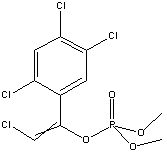Rabon
General
Type : Organophosphate,Insecticide
Chemical_Nomenclature : 2,4,5-trichloro-alpha-(chloromethylene)benzyl alcohol dimethyl phosphate\;
Canonical SMILES : COP(=O)(OC)OC(=CCl)C1=CC(=C(C=C1Cl)Cl)Cl
InChI : InChI=1S\/C10H9Cl4O4P\/c1-16-19(15,17-2)18-10(5-11)6-3-8(13)9(14)4-7(6)12\/h3-5H,1-2H3\/b10-5-
InChIKey : UBCKGWBNUIFUST-YHYXMXQVSA-N
Other name(s) : Stirophos,Tetrachlorvinphos,Stirofus,Gardona,Stirofos,Shell SD 8447 SD 8447,SD-8447,SD8447,TCVP,Dietreen rabond
MW : 365.96
Formula : C10H9Cl4O4P
CAS_number : 961-11-5
PubChem : 5284462
UniChem : UBCKGWBNUIFUST-YHYXMXQVSA-N
IUPHAR :
Wikipedia :

Target
References (7)
| Title : In vitro inhibition of blood cholinesterase activities from horse, cow, and rat by tetrachlorvinphos - Karanth_2003_Int.J.Toxicol_22_429 |
| Author(s) : Karanth S , Pope C |
| Ref : Int J Toxicol , 22 :429 , 2003 |
| Abstract : Karanth_2003_Int.J.Toxicol_22_429 |
| ESTHER : Karanth_2003_Int.J.Toxicol_22_429 |
| PubMedSearch : Karanth_2003_Int.J.Toxicol_22_429 |
| PubMedID: 14680990 |
| Title : Susceptibility of the bedbug, Cimex lectularius, to selected insecticides and various treated surfaces - Fletcher_1993_Med.Vet.Entomol_7_69 |
| Author(s) : Fletcher MG , Axtell RC |
| Ref : Med Vet Entomol , 7 :69 , 1993 |
| Abstract : Fletcher_1993_Med.Vet.Entomol_7_69 |
| ESTHER : Fletcher_1993_Med.Vet.Entomol_7_69 |
| PubMedSearch : Fletcher_1993_Med.Vet.Entomol_7_69 |
| PubMedID: 8435492 |
| Title : Horn fly (Diptera: Muscidae) insecticide resistance in Kentucky and Arkansas - Cilek_1991_J.Econ.Entomol_84_756 |
| Author(s) : Cilek JE , Steelman CD , Knapp FW |
| Ref : J Econ Entomol , 84 :756 , 1991 |
| Abstract : Cilek_1991_J.Econ.Entomol_84_756 |
| ESTHER : Cilek_1991_J.Econ.Entomol_84_756 |
| PubMedSearch : Cilek_1991_J.Econ.Entomol_84_756 |
| PubMedID: 1885841 |
| Title : Susceptibilities of northern fowl mite, Ornithonyssus sylviarum (Acarina: Macronyssidae), and chicken mite, Dermanyssus gallinae (Acarina: Dermanyssidae), to selected acaricides - Fletcher_1991_Exp.Appl.Acarol_13_137 |
| Author(s) : Fletcher MG , Axtell RC |
| Ref : Exp Appl Acarol , 13 :137 , 1991 |
| Abstract : Fletcher_1991_Exp.Appl.Acarol_13_137 |
| ESTHER : Fletcher_1991_Exp.Appl.Acarol_13_137 |
| PubMedSearch : Fletcher_1991_Exp.Appl.Acarol_13_137 |
| PubMedID: 1786744 |
| Title : Determining organohalides in animal fats using gel permeation chromatographic cleanup: repeatability study - Goodspeed_1991_J.Assoc.Off.Anal.Chem_74_388 |
| Author(s) : Goodspeed DP , Chestnut LI |
| Ref : J Assoc Off Analytical Chemistry , 74 :388 , 1991 |
| Abstract : Goodspeed_1991_J.Assoc.Off.Anal.Chem_74_388 |
| ESTHER : Goodspeed_1991_J.Assoc.Off.Anal.Chem_74_388 |
| PubMedSearch : Goodspeed_1991_J.Assoc.Off.Anal.Chem_74_388 |
| PubMedID: 2050618 |
| Title : 2-Chloro-1-(2,4,5-trichlorophenyl)vinyl Dimethyl Phosphate, a New Insecticide with Low Toxicity to Mammals - Whetstone_1966_J.Agric.Food.Chem_14_352 |
| Author(s) : Whetstone RR , Phillips DD , Sun YP , Ward LF.Jr , Shellenberger TE |
| Ref : Journal of Agricultural and Food Chemistry , 14 :352 , 1966 |
| Abstract : Whetstone_1966_J.Agric.Food.Chem_14_352 |
| ESTHER : Whetstone_1966_J.Agric.Food.Chem_14_352 |
| PubMedSearch : Whetstone_1966_J.Agric.Food.Chem_14_352 |
| PubMedID: |